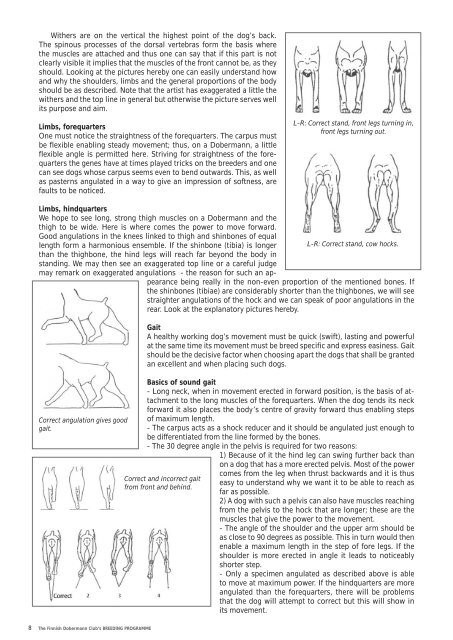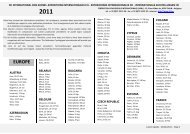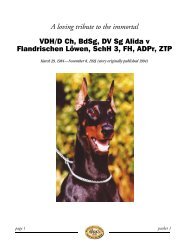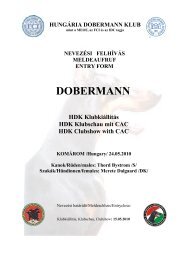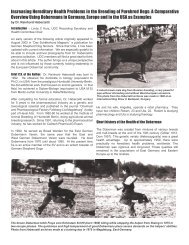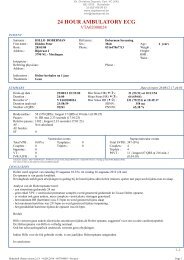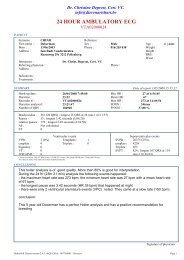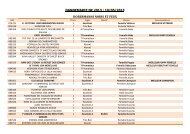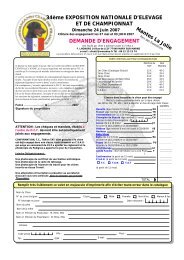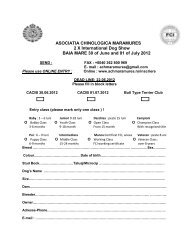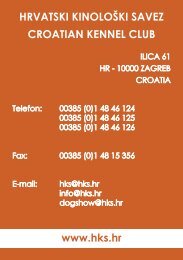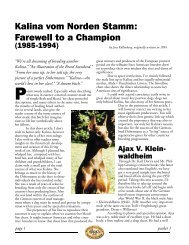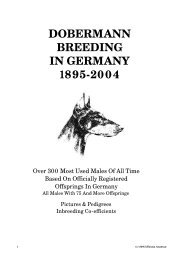Breeding Programme
Breeding Programme
Breeding Programme
You also want an ePaper? Increase the reach of your titles
YUMPU automatically turns print PDFs into web optimized ePapers that Google loves.
Withers are on the vertical the highest point of the dog’s back.<br />
The spinous processes of the dorsal vertebras form the basis where<br />
the muscles are attached and thus one can say that if this part is not<br />
clearly visible it implies that the muscles of the front cannot be, as they<br />
should. Looking at the pictures hereby one can easily understand how<br />
and why the shoulders, limbs and the general proportions of the body<br />
should be as described. Note that the artist has exaggerated a little the<br />
withers and the top line in general but otherwise the picture serves well<br />
its purpose and aim.<br />
Limbs, forequarters<br />
One must notice the straightness of the forequarters. The carpus must<br />
be flexible enabling steady movement; thus, on a Dobermann, a little<br />
flexible angle is permitted here. Striving for straightness of the forequarters<br />
the genes have at times played tricks on the breeders and one<br />
can see dogs whose carpus seems even to bend outwards. This, as well<br />
as pasterns angulated in a way to give an impression of softness, are<br />
faults to be noticed.<br />
L-R: Correct stand, front legs turning in,<br />
front legs turning out.<br />
Limbs, hindquarters<br />
We hope to see long, strong thigh muscles on a Dobermann and the<br />
thigh to be wide. Here is where comes the power to move forward.<br />
Good angulations in the knees linked to thigh and shinbones of equal<br />
length form a harmonious ensemble. If the shinbone (tibia) is longer L-R: Correct stand, cow hocks.<br />
than the thighbone, the hind legs will reach far beyond the body in<br />
standing. We may then see an exaggerated top line or a careful judge<br />
may remark on exaggerated angulations - the reason for such an appearance<br />
being really in the non-even proportion of the mentioned bones. If<br />
the shinbones (tibiae) are considerably shorter than the thighbones, we will see<br />
straighter angulations of the hock and we can speak of poor angulations in the<br />
rear. Look at the explanatory pictures hereby.<br />
Correct angulation gives good<br />
gait.<br />
Gait<br />
A healthy working dog’s movement must be quick (swift), lasting and powerful<br />
at the same time its movement must be breed specific and express easiness. Gait<br />
should be the decisive factor when choosing apart the dogs that shall be granted<br />
an excellent and when placing such dogs.<br />
Basics of sound gait<br />
- Long neck, when in movement erected in forward position, is the basis of attachment<br />
to the long muscles of the forequarters. When the dog tends its neck<br />
forward it also places the body’s centre of gravity forward thus enabling steps<br />
of maximum length.<br />
- The carpus acts as a shock reducer and it should be angulated just enough to<br />
be differentiated from the line formed by the bones.<br />
- The 30 degree angle in the pelvis is required for two reasons:<br />
1) Because of it the hind leg can swing further back than<br />
on a dog that has a more erected pelvis. Most of the power<br />
Correct and incorrect gait<br />
from front and behind.<br />
comes from the leg when thrust backwards and it is thus<br />
easy to understand why we want it to be able to reach as<br />
far as possible.<br />
2) A dog with such a pelvis can also have muscles reaching<br />
from the pelvis to the hock that are longer; these are the<br />
muscles that give the power to the movement.<br />
- The angle of the shoulder and the upper arm should be<br />
as close to 90 degrees as possible. This in turn would then<br />
enable a maximum length in the step of fore legs. If the<br />
shoulder is more erected in angle it leads to noticeably<br />
shorter step.<br />
- Only a specimen angulated as described above is able<br />
to move at maximum power. If the hindquarters are more<br />
angulated than the forequarters, there will be problems<br />
that the dog will attempt to correct but this will show in<br />
its movement.<br />
8 The Finnish Dobermann Club’s BREEDING PROGRAMME


